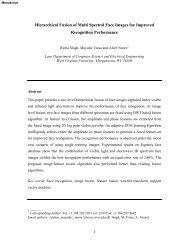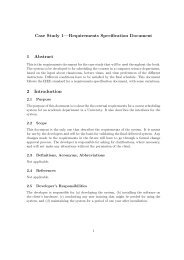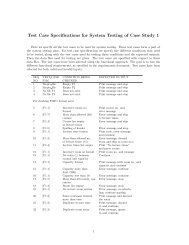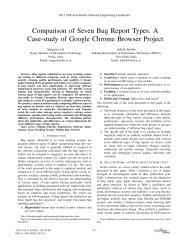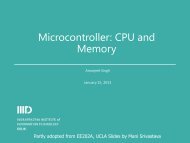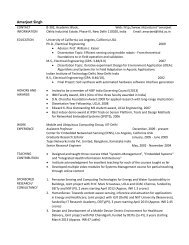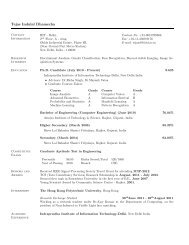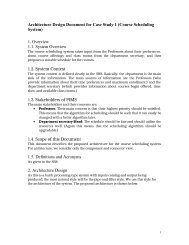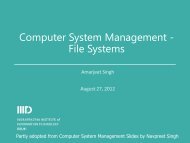Comparison of iris recognition algorithms - Intelligent ... - CiteSeerX
Comparison of iris recognition algorithms - Intelligent ... - CiteSeerX
Comparison of iris recognition algorithms - Intelligent ... - CiteSeerX
You also want an ePaper? Increase the reach of your titles
YUMPU automatically turns print PDFs into web optimized ePapers that Google loves.
Mayank VatsaDepartment <strong>of</strong> CSEZIT Kanpur, Indiamayank-richa@ yahoo.com<strong>Comparison</strong> <strong>of</strong> <strong>iris</strong> Recognition AlgorithmsRicha SinghDepartment <strong>of</strong> CSEIIT Kanpur, Indiamayank-richa@ yahoo.comP. GuptaDepartment <strong>of</strong> CSEIIT Kanpur, Indiapg@cse.iitk.ac.inAbstractIn this paper, we have studied various well known <strong>algorithms</strong>for <strong>iris</strong> <strong>recognition</strong>. Four <strong>algorithms</strong> due to Avila[5], Li Ma [9], Tisse [13] and Daugman [IS] are implementedand compared on the CASIA <strong>iris</strong> image database.The results show that the Daugman’s algorithm gave thehighest accuracy <strong>of</strong> 99.9%.KeywordsBiometrics, Iris Recognition, Iris Code, Wavelets.INTRODUCTIONPerson authentication has always been an attractive goal incomputer vision. Authentication systems based on humancharacteristics such as face, finger, <strong>iris</strong>, voice are known asBiometric Systems. Such types <strong>of</strong> systems are based onsignal and image processing based techniques. The basis <strong>of</strong>every biometric trait is to get the input signavimage andapply some <strong>algorithms</strong> like neural network, fuzzy logic,wavelet transform, etc to extract the prominent features.Biometrics include fingerprints, facial features, retina, <strong>iris</strong>,voice, gait, fingerprint, palm-prints, handwritten signaturesand hand geometry. Among the various traits, <strong>iris</strong> <strong>recognition</strong>has attracted a lot <strong>of</strong> attention because it has variousadvantageous factors like greater speed, simplicity and accuracycompared to other biometric traits. Iris <strong>recognition</strong>relies on the unique patterns <strong>of</strong> the human <strong>iris</strong> to identify orverify the identity <strong>of</strong> an individual.In this paper we have made a survey <strong>of</strong> various existing <strong>iris</strong><strong>recognition</strong> <strong>algorithms</strong>. We have also implemented four<strong>algorithms</strong> [5, 9, 13, 151 and comparison <strong>of</strong> the results obtainedis given in the paper. The comparison has been doneon the CASIA image database [22] provided by Pr<strong>of</strong>. T.Tan. In the next section we have discussed the structure <strong>of</strong><strong>iris</strong> and its importance as a biometric trait. In the third sectionvarious approaches <strong>of</strong> <strong>iris</strong> <strong>recognition</strong> have been described.Fourth section shows the experimental comparison<strong>of</strong> the implemented <strong>algorithms</strong>. Last section is the conclusionand future work.STRUCTURE OF IRISIris is distinct for every person, even the twins have different<strong>iris</strong> patterns and it remains same for whole <strong>of</strong> the life.Thus this technology is now considered as providing positiveidentification <strong>of</strong> an individual without contact and atvery high confidence levels. Sample <strong>iris</strong> images are shownin Figure 1.Figure 1. Example <strong>of</strong> Human Iris (from [12]).The very front <strong>of</strong> the eye is essentially made up <strong>of</strong> twoparts: the sclera or “white” portion <strong>of</strong> the eye, and cornea.The sclera consists <strong>of</strong> closely interwoven fibers and a smallsection in the front ancl center known as the cornea. Thecornea consists <strong>of</strong> fibers arranged in regular fashion. Convenientlythis makes the cornea transparent, allowing lightto filter in. Behind the cornea is the anterior chamber filledwith a fluid known as the aqueous humor. A spongy tissue,the ciliary bodies, arranged around the edge <strong>of</strong> the cornea,constantly produces the aqueous humor. Immersed in theaqueous humor is a rin,g <strong>of</strong> muscles commonly referred toas <strong>iris</strong>. The word <strong>iris</strong> is most likely derived from the Latinword for rainbow. It appears that the term was first appliedin the sixteenth century, making reference to this multicoloredportion <strong>of</strong> the eye [l]. The <strong>iris</strong> itself extends out infront <strong>of</strong> the lens, forming a circular array, with a variableopening in the center, o1:herwise known as the pupil [2]. Thepupil is not located exactly in the center <strong>of</strong> the <strong>iris</strong>, butrather slightly nasally and inferiorly (below the center) [3].The <strong>iris</strong>, which is made up <strong>of</strong> two bands <strong>of</strong> muscles, controlsthe pupil, the dilator, which contracts to enlarge thepupil, and the sphincter, which contracts to reduce the size<strong>of</strong> the pupil. The visual appearance <strong>of</strong> the <strong>iris</strong> is directlyrelated to its multi-layered construction. The anterior layeris divided into two basic regions, the central pupillary zoneand the surrounding ciliary zone. The border between theseareas is known as the collarette. The collarette appears as azigzag circumferential ridge, where the anterior borderlayer begins to drop into the pupil. The ciliary zone is characterizedby interlacing ridges resulting from stromal support.The ridges tend to vary with the state <strong>of</strong> the pupil(contracted or dilated).. Other striations can be seen as aneffect <strong>of</strong> the blood vessels beneath the surface. Crypts, neviand freckles make up the other main source <strong>of</strong> variation onthe <strong>iris</strong>. A crypt is an irregular atrophy <strong>of</strong> the border layer.Nevi are small elevations in the border layer. Freckles arelocal collections <strong>of</strong> chromataphores. The pupillary zone, onthe other hand tends )to be relatively flat. It occasionallyfeatures radiating spok:e-like processes and a pigment frillwhere the posterior layer’s heavily pigmented tissue showsat the pupil boundary [ 11.0-7803-8243-91041$17.00 2004 IEEE 354IClSlP 2004
authentic person and 100% rejection rate for fake?. Wanger. al. [ 121 used Gabor filters and 2-D wavelet transformsfor feature extraction. For identification weighted Euclideandistance classification has been used. This method is invariantto translation and rotation and tolerant to illumination.The classification rate on using Gabor is 98.3% and theaccuracy with wavelets 82.51%. Robert et. al. [13] introducednew algorithm for localization and extraction <strong>of</strong> <strong>iris</strong>.For localization a combination <strong>of</strong> the integro-differentialoperators with a Hough Transform is used and for featureextraction the concept <strong>of</strong> instantaneous phase or emergentfrequency is used. Iris code is generated by thresholdingboth the models <strong>of</strong> emergent frequency and the real andimaginary parts <strong>of</strong> the instantaneous phase. Finally thematching is performed using Hamming distance. Resultsgave 11% <strong>of</strong> the false reject rate was obtained. Lim et. al.[ 141 used Haar Wavelet transform to extract features from<strong>iris</strong> images. By applying the transform four times on image<strong>of</strong> size 450x60 and combining the features 87 bit featurevector was obtained. This feature vector is the compactrepresentation <strong>of</strong> the <strong>iris</strong> image. Finally for classification <strong>of</strong>feature vectors, weight vector initialization and winner selectionstrategy has been used. The <strong>recognition</strong> rate obtainedis around 98.4%. In [16] two new methods <strong>of</strong> thestatistical and computer evaluations <strong>of</strong> the <strong>iris</strong> structure <strong>of</strong> ahuman eye in view <strong>of</strong> personal identification have beenproposed which are based partly on the correlation analysisand partly on the median binary code <strong>of</strong> commensurableregions <strong>of</strong> digitized <strong>iris</strong> image. Similarly method <strong>of</strong> eye-<strong>iris</strong>structure characterization using statistical and spectralanalysis <strong>of</strong> color <strong>iris</strong> images is considered in [17]. Gurianovet.al. [I71 used Wiener spectra for characterization <strong>of</strong> <strong>iris</strong>patterns. In [lS, 201 human <strong>iris</strong> structure is explained andclassified using coherent Fourier spectra <strong>of</strong> the opticaltransmission.In [21], an efficient biometric security algorithm for <strong>iris</strong><strong>recognition</strong> system with high performance and high confidencehas been described. The system is based on an empiricalanalysis <strong>of</strong> the <strong>iris</strong> image and it is split in severalsteps using local image properties. The various steps arecapturing <strong>iris</strong> pattems; determining the location <strong>of</strong> <strong>iris</strong>boundaries; converting the <strong>iris</strong> boundary to the stretchedpolar coordinate system; extracting the <strong>iris</strong> code based ontexture analysis using wavelet transforms and classification<strong>of</strong> the <strong>iris</strong> code. The proposed system use the wavelet transformsfor texture analysis, and it depends heavily on theknowledge <strong>of</strong> general structure <strong>of</strong> human <strong>iris</strong>. The systemhas been implemented and tested using a dataset <strong>of</strong> 240samples <strong>of</strong> <strong>iris</strong> data with different contrast quality.COMPARISONWe have implemented four <strong>algorithms</strong> [5, 9, 13, 151 basedon Iris Code. The <strong>algorithms</strong> are implemented in MATLAB6.5. These <strong>algorithms</strong> have been tested on the CASIA IrisImage Database 1221 as this is the only database availablein public domain. Thc: database includes 756 <strong>iris</strong> imagesfrom 108 individuals. For each eye, 7 images are therewhich have been captured in two sessions; three samplesare collected in the first session and four in the second session.We have taken three images for training purpose andrest <strong>of</strong> the four for testing. The performance results arebased on error rates: False Acceptance Rate (FAR) andFalse Rejection Rate (FRR); and the overall accuracy. Thepercentage accuracy based on FAR and FRR <strong>of</strong> the implemented<strong>algorithms</strong> is shown in Table 1. This table showsthat the Daugman’s algorithm [15] gives the maximum accuracyamong the four.Table 1. Performance <strong>of</strong> AlgorithmsAlgorithmOverall 70FAIUFRR[Reference]AccuracyAvila [5] 0.0312.080.02/ 1.98Tisse [ 131 1.8418.7999.90Figure 2 shows a comparison among the <strong>algorithms</strong>. In thisexperiment we have compared the FAR, FRR and overallaccuracy <strong>of</strong> the <strong>algorithms</strong> to each other, i.e. FAR for 1 iscompared to FAR <strong>of</strong> 2, 3 and 4 and in all [ 151 gives the bestperformance.AlgorithmFigure 2. <strong>Comparison</strong> <strong>of</strong> Error Rates and Accuracy <strong>of</strong>Algorithms.356 IClSlP 2004
Case A: I IInput Image <strong>iris</strong> Code Matched imageFigure 3. Results <strong>of</strong> Iris Recognition.Figure 3 shows sample results on Daugman’s algorithm11.51. The <strong>iris</strong> image along with their <strong>iris</strong> codes and matchedresults are shown in different cases. In Case A, the imagewith varying illumination is shown and Case B shows theresults with noise added to it.CONCLUSIONThis paper presents a review <strong>of</strong> the existing <strong>algorithms</strong>available for <strong>iris</strong> <strong>recognition</strong>. The <strong>algorithms</strong> are generallydivided into four steps, viz. Localization, Normalization,Feature Extraction and Matching. Iris <strong>recognition</strong> technologyis able to give highly accurate results for human identification.But this technology needs more attention to overcomethe disadvantages <strong>of</strong> the existing <strong>algorithms</strong>. Thispaper also shows an experimental comparison <strong>of</strong> four <strong>algorithms</strong>[5, 9, 13, 151 which shows that Daugman’s [15] algorithmgives maximum accuracy. Future work would be tomake a database <strong>of</strong> large number <strong>of</strong> people which includesa large number <strong>of</strong> variations for illumination and size. Weare working to develop an efficient algorithm for <strong>iris</strong> <strong>recognition</strong>using less expensive cameras and other hardware sothat the cost can be reduced upto some extent.ACKNOWLEDGEMENTSAuthors wish to acknowledge Dr. J. Daugman and Dr. T.Tan for providing <strong>iris</strong> images. This work has been done as apart <strong>of</strong> the project sponsored by the Department <strong>of</strong> Communicationand Information Technology, INDIA.REFERENCES[ 11 Wildes, Richard P, Iris Recognition: An EmergingBiometric Technology, Proceedings <strong>of</strong> the IEEE. Vol.85, NO. 9, (1999), pp.1348-1363.[2] Daugman J. G., High coifidence visual <strong>recognition</strong> <strong>of</strong>persons by a test <strong>of</strong> statistical independence, IEEETransactions on Pattern Analysis and Machine Intelligence,Volume: 15, No. 1 I, (l993), pp. 1148-1 161.[3] Boles W.W, Boashash B., A human identificationtechnique using inzages <strong>of</strong> the <strong>iris</strong> and wavelet transform,IEEE Transactions on Signal Processing, Vol.46, NO. 4, (1998), pp. 1185-1188.[4] Mallat S. G., Zero-crossing <strong>of</strong> a Wavelet Transform,IEEE Transactions, on Information Theory, Vol. 37.No. 14, (1991), pp. 1019 - 1033.[5] Sanchez-Avila C., Sanchez-Rei110 R.; de Martin-RocheD., Iris <strong>recognition</strong> for biometric identification usingdyadic wavelet transform zero-crossing, Proceedings<strong>of</strong> the IEEE 35th International. Camahan Conferenceon Security Technology, (2001). pp. 272 -277.[6] Seung-In Noh, Kwanghuk Pae, Chulhy Lee, JaihieKim, Multiresolution Independent Component Identification,Proceedings <strong>of</strong> the 2002 International TechnicalConference on CircuitdSystems, Computers andCommunications, Phuket, Thailand, (2002).[7] Ma, Li, Tan, Tieniu, Wang, Yunhong, Iris <strong>recognition</strong>based on multichannel Gabor filtering, Proceedings <strong>of</strong>the International Conference on Asian Conference onComputer Vision, (2002), pp. 1-5.[8] Dargham, J. A., Chekima, A., Liau Chung Fan and LyeWil Liam, Iris <strong>recognition</strong> using sev- organizing neuralnetwork, Student Conference on Research and Development,(2002), pp. 169 -172.[9] Ma, Li, Tan, Tieniu, Wang, Yunhong, Iris <strong>recognition</strong>using circular symmetric filters, Proceedings <strong>of</strong> the16th International Conference on Pattern Recognition,V01.2, (2002), pp. 414 -417.[ 101 http://www.cl.cam.ac.uk/users/jgdl OOO/[ 111 Chen Wen-Shiung,Yuan Shang-Yuan, A Novel PersonalBiometric Authentication Technique Using HumanIris Based on Fractal Dimension Features, Proceedings<strong>of</strong> the International Conference on Acoustics,Speech and Signal Processing, (2003).[12] Yong Zhu, Tieniu Tan, Yunhong Wang, BiometricPersonal Identification Based on Iris Patterns, Proceedings<strong>of</strong> the IEEE International Conference on PatternRecognition, (2000), pp. 2801-2804[ 131 Christel-LoFc Tisse, Lionel Torres, Michel Robert,Person Identification Technique Using Human IrisRecognition, Proceedings <strong>of</strong> the 15th InternationalConference on Vision Interface (2002).[ 141 Lim S., Lee K., Byeon O., Kim T., Efficient Iris Recognitionthrough Improvement <strong>of</strong> Feature Vector andClasszjier, Journal <strong>of</strong> Electronics and TelecommunicationResearch Institute, Vol. 23, No. 2, (2001), pp. 61 -70.[ 151 Daugman J. G;, Statistical Richness <strong>of</strong> Visual PhaseInformation: Update on Recognizing Persons by IrisPatterns, International Journal <strong>of</strong> Computer Vision,Vol. 45, NO. 1, (2001), pp. 25 - 38.[ 161 Machala, Libor, Pospisil, Jaroslav, Alternatives <strong>of</strong> thestatistical evaluation <strong>of</strong> the hunzan <strong>iris</strong> structure, Proceedings<strong>of</strong> the SPIE Vol. 4356, (2001) pp. 385-393.. ‘357 IClSlP 2004
[ 171 Gurianov, E. V., Zimnyakov. Dmitry A., Galanzha,Vladimir A., Iris patterns characterization by use <strong>of</strong>Wiener spectra analysis: potentialities and restrictions,Proceedings <strong>of</strong> the SPIE Vol. 4242, (2001), pp. 286-290.[ 181 Kois Petr, Muron Ales, Pospisil Jaroslav, Human <strong>iris</strong>structure by the_ method <strong>of</strong> coherent optical Fouriertransform, Proceedings <strong>of</strong> the SPIE Vol. 4356, (2001),pp. 394-400.[ 191 Della Vecchia, Michael A., Chmielewski Thomas, CamusTed A., Salganic<strong>of</strong>f Marcos, Negin Michael,Methodology and apparatus for using the human <strong>iris</strong>as a robust biometric, Proceedings <strong>of</strong> the SPIE Vol.3246, (1998), pp. 65-74.[20] Ales Muron, Petr K.ois and Jaroslav Pospisil, Identification<strong>of</strong> persons by means <strong>of</strong> the Fourier spectra <strong>of</strong>the optical transmission binary models <strong>of</strong> the human.<strong>iris</strong>es, Optics Communications, Vol. 192, (2001) pp.161 -167.[21] Jafar M. H. Ali Abclul Ella Hassanien, An Iris RecognitionSystem to Enhance E-security Environment Basedon Wavelet Theory, AM0 - Advanced Modeling andOptimization, Volume 5, No. 2, (2003), pp. 93-104.[22] http://nlpr-web.ia.ac.cn/englisNirds/<strong>iris</strong>database.htm358 IClSlP 2004



